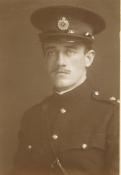
|
The King's School Canterbury |
Roll of Honour |
| Lieutenant Stuart Underwood BAILY | |
|
490th (Home Counties) Field Company, Royal Engineers Date of birth: 17th May 1886 Date of death: 15th September 1918 Died aged 32 Buried at Fairlight Churchyard at Hastings in Sussex |

|
| He was born at St Leonards-on-Sea on the 17th of May 1886 the eldest son of Cornwall Stuart Baily, solicitor, and Marion (nee Underwood) of 6 Danes Road, St Leonards-on-Sea in Kent. He was educated at the King’s School Canterbury from May 1901 to July 1903. On leaving school he went to Glasgow to study locomotive engineering and worked for the Caledonian Locomotive Works there from 1904 to 1910. While he was there he lived at 1 Kersland Street, Glasgow. Later in 1910 he went to Canada to work on the Grand Trunk Railway in Montreal. He returned to the UK on board the SS "Alsatian" landing at Liverpool on the 6th of August 1914 and enlisted as a Private in the Hastings contingent of the Royal Sussex Regiment. He applied for a commission in the 3/8th Battalion Middlesex Regiment on the 14th of February 1915 and was passed as fit for general service at a medical examination which was undertaken on the same day at the Queen Alexandra's Military Hospital, Millbank. There it was recorded that he was five feet eleven and a half inches tall. He was commissioned as a 2nd Lieutenant in the Battalion on the 2nd of March 1915 and he embarked for France on the 13th of July 1915. On the 27th of December 1915 it was recommended that he transfer to the Royal Engineers given his knowledge of engineering. He transferred to the 1/1st (Home Counties) Field Company Royal Engineers, which later became the 490th (Home Counties) Field Company, on the 31st of January 1916. By June 1916 the Company was at Mazingarbe south of Bethune from before moving to Albert in July where they were involved in the first day of the fighting on the Somme. By October 29th the company was at Longueval for the attack on Le Transloy. They remained in the Somme region until June 1917 when they moved to the Ypres area. He went on leave to England from Boulogne on the 26th of June to the 6th of July 1917 and was promoted to Lieutenant on the 1st of July 1917. Later that month he received a GOC Certificate for gallant conduct and coolness under fire for laying track east of Ypres whilst under heavy fire during operations on the 31st of July and the 1st of August 1917. It was while he was at Dominion Camp near Ypres when enemy aircraft bombed of the camp on the 11th of August 1917, killing the Company's Commanding Officer, Major Cecil Clive Bryan DSO, severely wounding Stuart Baily along with one other officer and six other ranks. He had been wounded in the back, the scalp and the hand. He was evacuated to England from Calais on the 18th of August 1917 and landed at Dover the same day. A Medical Board was convened on the 5th of October 1917 which described his condition: - "This officer was wounded at Ypres on 11.8.17. Suffering from wounds back and scalp. His wounds are healed and in accordance with A.C.I. 412-17 he is granted 3 weeks leave and to await orders from War Office." On his release from hospital he joined the 5th (Reserve) Company, Royal Engineers and was posted to Maidenhead for light duties. He was later posted to Caterham for a course in bridge building and then to Aldershot where he began to be troubled by his wounds and was admitted to hospital at Weymouth. A Medical Board sat at Burdon Military Hospital, Weymouth on the 29th of March 1918 to report on his condition: - "Tumour left side of neck, myalgia, neurasthenia. He states he caught a chill in December 1917, was laid up in bed for a week with pain in left loin, thigh and since then he has had several acute attacks. There is a growth under the left sternocleidomastoid the size of a hens egg first noticed 3 weeks ago, is painful and tender. His general health has not been good since he was wounded by a bomb from an aeroplane in August 1917 on active service in France. Not improving. General condition and appearance not good. He is thin, weak and has lost flesh latterly. The tumour is not moveable and has grown rapidly. It is possibly a sarcoma. His myalgia is still troublesome. He suffers from traumatic neurasthenia - the result of the explosion which caused his wound which is now healed". A further Medical Boars which sat at Netley Hospital on the 24th of May 1918 concluded that he was no longer fit for service and that he should leave the army. He was sent home on the 25th of May 1918 relinquished his commission on the grounds of ill health on the 29th of June 1918 and was granted the rank of Honorary Lieutenant. He died at his parent's home at St Leonards a few weeks later with his father at his bedside. The cause of death recorded on his death certificate reads: - "Sarcoma and the hardships and wounds received during campaigning." His Sergeant Major wrote:- “We are all very sorry to hear about Lieutenant Baily. He was one of the finest officers, a born leader and one to inspire confidence in all under him; he is of the type that can sorely be spared.” |
|
Back